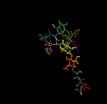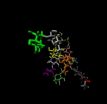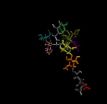(Press-News.org) VIDEO:
Here are movies of dynamic behavior of a sugar chain on the basis of NMR-validated simulations. This chain has a particular sugar (green circle).
Click here for more information.
We often experience difficulties in identifying the accurate shape of dynamic and fluctuating objects. This is especially the case in the nanoscale world of biomolecules. The research group lead by Professor Koichi Kato of the Institute for Molecular Science, National Institutes of Natural Sciences developed a methodology for quantitatively describing the dynamic behaviors of complicated sugar chains in solution at atomic resolution by combining a sophisticated NMR spectroscopic approach with an ingenious molecular dynamics simulation technique. This study has just been published in Angewandte Chemie International Edition (published online on September 4, 2014), a scientific journal that is published on behalf of the German Chemical Society.
The sugar chains are flexible accessories decorating the surface of proteins. These variable accessories actually mediate protein-protein communication and even determine the fates of the protein. In other words, the sugar chains serve as transformable "code" that governs the protein's action in our body. For example, it has been revealed that particular sugar chains modifying lipids on cell surfaces offer acceptor sites for viral infections and trigger conformational changes of proteins involved in neurodegenerative disorders including Alzheimer's disease. Hence, decoding the sugar codes is desired not only for better understanding the molecular mechanisms behind a variety of biological processes but also for designing new drugs targeting these processes. However, conformational characterization of the sugar chains has been hampered by their dynamic properties.
VIDEO:
Here are movies of dynamic behavior of a sugar chains on the basis of NMR-validated simulations. This chain does not have a particular sugar.
Click here for more information.
Many experimentalists and theorists have taken on the challenge to solve this problem. NMR spectroscopy is one of the most promising experimental approaches for conformational analyses of the sugar chains because of its ability to determine geometrical arrangements of the atoms constituting biomolecules in solution. However, if a biomolecule undergoes rapid motion as in the case of the sugar chains, NMR provides information averaged over all its possible conformational snapshots. By contrast, a molecular dynamics simulation can provide a movie that describes the dynamic behaviors of sugar chains. However, the simulation results should be experimentally validated to guarantee their accuracy.
Kato's research group successfully combined these two complementary approaches and thereby captured distinct conformational snapshots of two very similar sugar chains in dynamic motion. This success was achieved on the basis of several key breakthrough techniques. Firstly, the group employed genetically engineered yeast cells for production of homogeneous oligosaccharides in sufficient quantity with stable isotope labeling, which is necessary for detailed NMR analyses. Secondly, a paramagnetic probe was introduced specifically at one end of the oligosaccharides in order to obtain atomic-distance information. Thirdly, they used the high-field NMR spectrometers and the supercomputer facility operated by the Institute for Molecular Science.
As Professor Kato notes, "This success enables us quantitative and highly sensitive characterization of minor but biologically relevant conformational species of sugar chains and will open the door for observing the dynamic behavior of flexible biomolecules as potential drug targets".
INFORMATION: END
Decoding 'sweet codes' that determine protein fates
Depicting the dynamic structures of sugar chains by an NMR-validated simulation
2014-09-15
ELSE PRESS RELEASES FROM THIS DATE:
You don't walk alone
2014-09-15
65 million people around the world today suffer from epilepsy, a condition of the brain that may trigger an uncontrollable seizure at any time, often for no known reason. A seizure is a disruption of the electrical communication between neurons, and someone is said to have epilepsy if they experience two or more unprovoked seizures separated by at least 24 hours.
Epilepsy is the most common chronic disease in pediatric neurology, with about 0.5% of children developing epilepsy during their lifetime. A further 30% of epileptic children develop refractory ...
Walking or cycling to work improves wellbeing, University of East Anglia researchers find
2014-09-15
Walking or cycling to work is better for people's mental health than driving to work, according to new research by health economists at the University of East Anglia and the Centre for Diet and Activity Research (CEDAR).
A report published today reveals that people who stopped driving and started walking or cycling to work benefited from improved wellbeing. In particular, active commuters felt better able to concentrate and were less under strain than if they travelled by car.
These benefits come on top of the physical health benefits of walking and cycling that are ...
Nature: New drug blocks gene driving cancer growth
2014-09-15
When active, the protein called Ral can drive tumor growth and metastasis in several human cancers including pancreatic, prostate, lung, colon and bladder. Unfortunately, drugs that block its activity are not available. A study published today in the journal Nature uses a novel approach to target the activation of these Ral proteins: "When you want to keep an alligator from biting you, you can tie its mouth shut. We took another approach – we put a stick in its mouth to hold it open," says Dan Theodorescu, MD, PhD, professor of Urology and Pharmacology, director of the ...
Blood-cleansing biospleen device developed for sepsis therapy
2014-09-15
Things can go downhill fast when a patient has sepsis, a life-threatening condition in which bacteria or fungi multiply in a patient's blood -- often too fast for antibiotics to help. A new device inspired by the human spleen and developed by a team at Harvard's Wyss Institute for Biologically Inspired Engineering may radically transform the way doctors treat sepsis.
"Even with the best current treatments, sepsis patients are dying in intensive care units at least 30 percent of the time," said Mike Super, Ph.D., Senior Staff Scientist at the Wyss Institute. "We need ...
Muscular dystrophy: Repair the muscles, not the genetic defect
2014-09-15
ANN ARBOR, Mich.---A potential way to treat muscular dystrophy directly targets muscle repair instead of the underlying genetic defect that usually leads to the disease.
Muscular dystrophies are a group of muscle diseases characterized by skeletal muscle wasting and weakness. Mutations in certain proteins, most commonly the protein dystrophin, cause muscular dystrophy in humans and also in mice.
A University of Michigan team led by cell biologist Haoxing Xu, discovered that mice missing a critical calcium channel inside the cell, called TRPML1, showed similar muscle ...
Three's a charm: NIST detectors reveal entangled photon triplets
2014-09-15
BOULDER, Colo – Researchers at the University of Waterloo in Canada have directly entangled three photons in the most technologically useful state for the first time, thanks in part to superfast, super-efficient single-photon detectors developed by the National Institute of Standards and Technology (NIST).
Entanglement is a special feature of the quantum world in which certain properties of individual particles become linked such that knowledge of the quantum state of any one particle dictates that of the others. Entanglement plays a critical role in quantum information ...
The Lancet: Some lung cancer patients could live longer when treated
2014-09-15
Treating advanced small-cell lung cancer (SCLC) with thoracic (or chest) radiation therapy in addition to standard treatment significantly prolongs long-term survival and reduces cancer recurrence in the chest by almost 50%, according to new research published in The Lancet and being presented simultaneously at ASTRO's 2014 Annual Meeting in San Francisco.
The authors say that as the thoracic radiotherapy is well tolerated, it should to be routinely offered to all SCLC patients with extensive disease whose cancer responds to chemotherapy.
SCLC is an aggressive cancer ...
Researchers find neural compensation in people with Alzheimer's-related protein
2014-09-15
Berkeley — The human brain is capable of a neural workaround that compensates for the buildup of beta-amyloid, a destructive protein associated with Alzheimer's disease, according to a new study led by researchers at the University of California, Berkeley.
The findings, to be published Sunday, Sept. 14, in the journal Nature Neuroscience, could help explain how some older adults with beta-amyloid deposits in their brain retain normal cognitive function while others develop dementia.
"This study provides evidence that there is plasticity or compensation ability in ...
Asian monsoon much older than previously thought
2014-09-15
The Asian monsoon already existed 40 million years ago during a period of high atmospheric carbon dioxide and warmer temperatures, reports an international research team led by a University of Arizona geoscientist.
Scientists thought the climate pattern known as the Asian monsoon began 22-25 million years ago as a result of the uplift of the Tibetan Plateau and the Himalaya Mountains.
"It is surprising," said lead author Alexis Licht, now a research associate in the UA department of geosciences. "People thought the monsoon started much later."
The monsoon, the largest ...
University of Leeds press release: One care lapse can be fatal for heart attack patients
2014-09-15
University of Leeds research has revealed that heart attack patients have a 46% increased chance of death within a month of discharge if they miss any one of nine types of care.
There is also a 74% increased chance of dying within one year if any one component of care is missed.
The nine pathways of care that have been identified are pre-hospital electrocardiogram, acute use of aspirin, restoring blood flow to the heart (known as reperfusion), prescription at hospital discharge of aspirin, timely use of four types of drug for heart attack (ACE-inhibitors, beta-blockers, ...
LAST 30 PRESS RELEASES:
An ‘illuminating’ design sheds light on cholesterol
Who is more likely to get long COVID?
Study showcases resilience and rapid growth of “living rocks”
Naval Research Lab diver earns Office of Naval Research 2025 Sailor of the Year
New Mayo-led study establishes practical definition for rapidly progressive dementia
Fossil fuel industry’s “climate false solutions” reinforce its power and aggravate environmental injustice
Researchers reveal bias in a widely used measure of algorithm performance
Alcohol causes cancer. A study from IOCB Prague confirms damage to DNA and shows how cells defend against it
Hidden viruses in wastewater treatment may shape public health risks, study finds
Unlock the power of nature: how biomass can transform climate mitigation
Biochar reshapes hidden soil microbes that capture carbon dioxide in farmland
Reducing saturated fat intake shows mortality benefit, but only in high-risk individuals
Manta rays create mobile ecosystems, study finds
Study: Mixed results in using lipoic acid to treat progressive multiple sclerosis
Norbert Holtkamp appointed director of Fermi National Accelerator Laboratory
New agentic AI platform accelerates advanced optics design
Biologists discover neurons use physical signals — not electricity — to stabilize communication
Researchers discover that a hormone can access the brain by hitchhiking
University of Oklahoma researcher awarded funding to pursue AI-powered material design
Exploring how the visual system recovers following injury
Support for parents with infants at pediatric check-ups leads to better reading and math skills in elementary school
Kids’ behavioral health is a growing share of family health costs
Day & night: Cancer disrupts the brain’s natural rhythm
COVID-19 vaccination significantly reduces risk to pregnant women and baby
The role of vaccination in maternal and perinatal outcomes associated with COVID-19 in pregnancy
Mayo Clinic smartwatch system helps parents shorten and defuse children's severe tantrums early
Behavioral health spending spikes to 40% of all children’s health expenditures, nearly doubling in a decade
Digital cognitive behavioral treatment for generalized anxiety disorder
Expenditures for pediatric behavioral health care over time and estimated family financial burden
Air conditioning in nursing homes and mortality during extreme heat
[Press-News.org] Decoding 'sweet codes' that determine protein fatesDepicting the dynamic structures of sugar chains by an NMR-validated simulation








